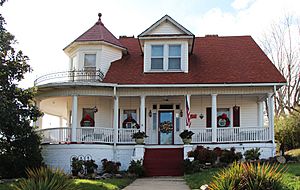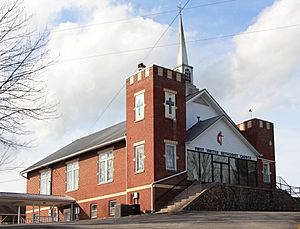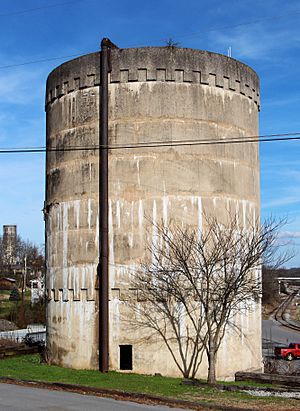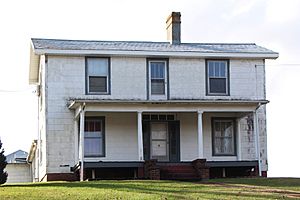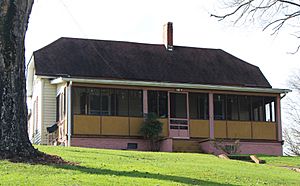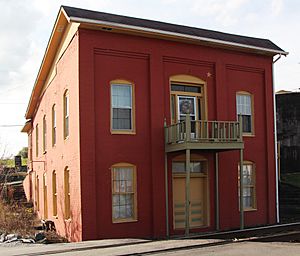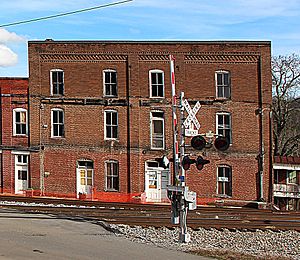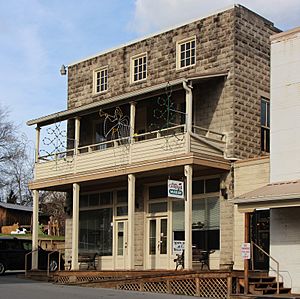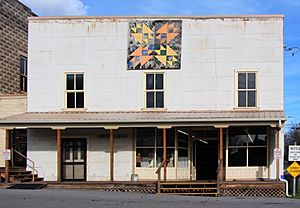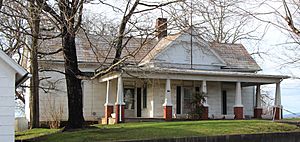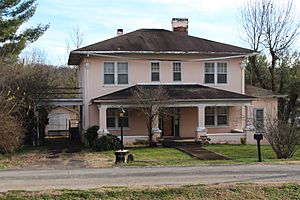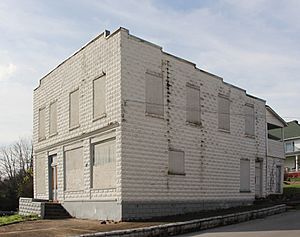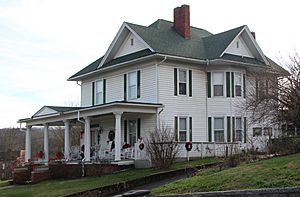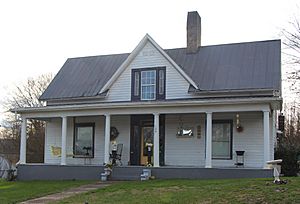Bulls Gap Historic District facts for kids
Quick facts for kids |
|
|
Bulls Gap Historic District
|
|
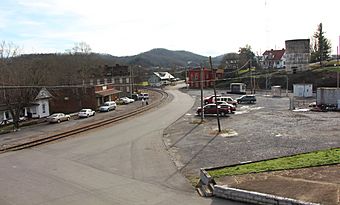
Bulls Gap Historic District, Bulls Gap, Tennessee; looking south
|
|
| Lua error in Module:Location_map at line 420: attempt to index field 'wikibase' (a nil value). | |
| Location | S. Main, Church, McGregor, Price and Mill Sts., Bulls Gap, Tennessee |
|---|---|
| Area | 24 acres (9.7 ha) |
| Architectural style | Bungalow/craftsman, Queen Anne |
| NRHP reference No. | 87001232 |
| Added to NRHP | July 30, 1987 |
The Bulls Gap Historic District is a special area in the town of Bulls Gap. This town is located in the southeastern part of Hawkins County in East Tennessee. Bulls Gap gets its name from a natural pass or "gap" in Bays Mountain.
Contents
Discovering Bulls Gap
Bulls Gap is a unique town because of its important location. Two main railway lines cross through the town. One line goes from northeast to southwest. The other runs from northwest to southeast. These two lines are connected by smaller tracks. They form a triangle shape. The oldest business area of Bulls Gap is found right in the middle of these railway tracks.
Streets and Buildings
Most of the historic buildings are along South Main Street. This street is long and winding. It mainly runs north and south. The northern end of South Main Street starts near U.S. Route 11E and Tennessee State Route 66. From there, it goes downhill.
The northern part of South Main Street has mostly homes. This residential area continues a short distance past a bridge. After a big turn in the road, the business area begins. Here, you'll find several stores. They are built around the railway tracks. This is also where the old train station used to be. After South Main Street crosses the tracks and Church Street, the area becomes residential again.
Historic Treasures
The Bulls Gap Historic District has many important buildings and structures. These are called "contributing resources." There are 48 buildings and 8 structures that help make the district special. The buildings include 22 homes, 2 churches, 10 business buildings, and 14 smaller outbuildings. The structures include 3 water towers, 2 bridges, and 3 other outbuildings.
The Story of Bulls Gap
The history of Bulls Gap goes back a long time. In 1792, a man named John Bull received a land grant. He was a gunsmith. His land was 55 acres on Bays Mountain. It was near an important path over the mountain. John Bull ran a stagecoach service through this path. Because of him, the path became known as Bull's Gap. We don't know much about the very first days of settlement here.
Bulls Gap and the Civil War
Bulls Gap became a very important place during the American Civil War. This was because of the crucial railway line through the mountains. Both sides in the war wanted to control the town. Bulls Gap became a fortified town. Many battles were fought here between 1863 and 1865. The goal was to gain control of the town and its railroad. For most of the war, the Union Army kept control of Bulls Gap and the railway.
Historic Buildings You Can See
Here are some of the notable buildings in the Bulls Gap National Historic District:
| Name | Year Built | Architectural Style | Comments |
|---|---|---|---|
| Parley Quillen Residence | c. 1880 | Vernacular architecture | |
| Marshall Residence | c. 1895 | Queen Anne | |
| Methodist Church | 1931 | Vernacular architecture | |
| Southern Railway Water Tower | c. 1910 | Notice the large dentils over the door and near the top. | |
| McCullough Residence | c. 1870 | Vernacular architecture | Also known as J. W. Blackburn House. |
| Miller House | c. 1920 | Vernacular architecture | This building does not contribute to the historic district. |
| Residence | c. 1925 | Vernacular architecture | |
| Gilley Hotel | c. 1895 | Vernacular architecture | The Gilley Hotel has two stories. It is connected to the Smith Hotel, which has three stories. |
| Old Guima Hotel | c. 1856 | Vernacular architecture | Also known as Granny Feathers House. The back of the building is at 100 Church Street. |
| Smith Hotel | c. 1880 | Vernacular architecture | This hotel is next to the Gilley Hotel, to the north. |
| York Quillen Building | c. 1900 | Vernacular architecture | Today, this building is used as a museum and the town hall. |
| York Quillen Store | c. 1880 | Vernacular architecture | |
| Myers Residence | c. 1895 | Queen Anne Cottage | |
| Moody Residence | c. 1900 | American Craftsman | |
| J. B. Willoughby Building | c. 1910 | Vernacular commercial | Also known as the Bulls Gap Citizen Union Bank. |
| Willoughby Residence | c. 1905 | Queen Anne and Colonial Revival architecture | Also known as Dr. W. Guy Justis House. |
| McCollom House | c. 1895 | Gothic and Greek Revial elements, Vernacular | |
| First Baptist Church | c. 1925 | Vernacular Gothic architecture |



